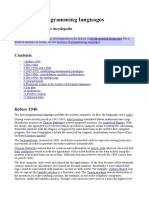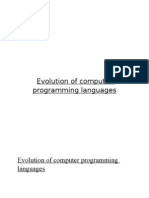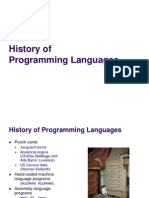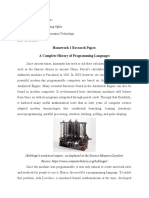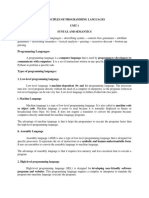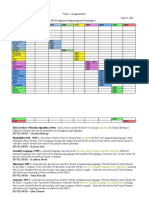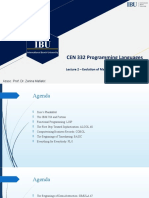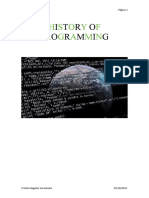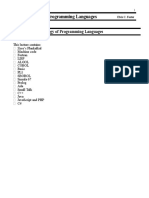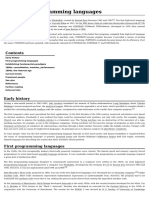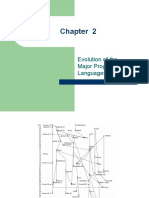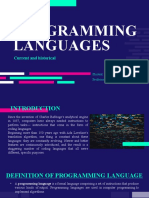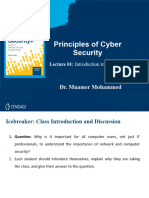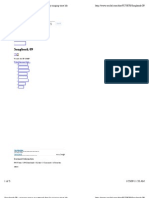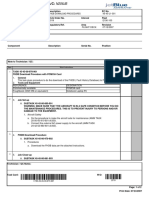History of Programming
Languages
�Prehistory
The first programming languages predate the modern computer. From the first, the languages were codes. Herman Hollerith
realized that he could encode information on punch cards when he observed that railroad train conductors would encode the
appearance of the ticket holders on the train tickets using the position of punched holes on the tickets. Hollerith then proceeded to
encode the 1890 census data on punch cards which he made the same size as the boxes for holding US currency. (The dollar bill
was later downsized.)
In the first decades of the twentieth century, numerical calculations were based on decimal numbers. Eventually it was realized
that logic could be represented with numbers, as well as with words. For example, Alonzo Church was able to express the lambda
calculus in a formulaic way. The Turing machine was an abstraction of the operation of a tape-marking machine, for example, in
use at the telephone conference calling companies. However, unlike the lambda calculus, Turing's code does not serve well as a
basis for higher-level languages - its principal use is in rigorous analyses of algorithmic complexity.
Like many "firsts" in history, the first modern programming language is hard to identify. From the start, the restrictions of the
hardware defined the language. Punch cards allowed 80 columns, but some of the columns had to be used for a sorting number
on each card. Fortran included some keywords which were the same as English words, such as "IF", "GOTO" (go to) and
"CONTINUE". The use of a magnetic drum for memory meant that computer programs also had to be interleaved with the
rotations of the drum. Thus the programs were more hardware dependent than today.
To some people the answer depends on how much power and human-readability is required before the status of "programming
language" is granted. Jacquard looms and Charles Babbage's Difference Engine both had simple, extremely limited languages for
describing the actions that these machines should perform. One can even regard the punch holes on a player piano scroll as a
limited domain-specific programming language, albeit not designed for human consumption.
�The 1940s
In the 1940s the first recognizably modern, electrically powered computers were created. The
limited speed and memory capacity forced programmers to write hand tuned assembly
language programs. It was soon discovered that programming in assembly language required
a great deal of intellectual effort and was error-prone.
In 1945, Konrad Zuse published details of his programming language Plankalkül. However, it
was not implemented in his time and his original contributions were isolated from other
developments because Germany was isolated during the war.
Some important languages that were developed in this time period include:
1943 - Plankalkül (Konrad Zuse)
1943 - ENIAC coding system
1949 - C-10
�The 1950s and 1960s
In the 1950s the first three modern programming languages whose descendants are still in widespread use today
were designed:
FORTRAN, the "FORmula TRANslator", invented by John W. Backus et al.;
LISP, the "LISt Processor", invented by John McCarthy et al.;
COBOL, the COmmon Business Oriented Language, created by the Short Range Committee, heavily
influenced by Grace Hopper.
Another milestone in the late 1950s was the publication, by a committee of American and European computer
scientists, of "a new language for algorithms"; the Algol 60 Report (the "ALGOrithmic Language"). This report
consolidated many ideas circulating at the time and featured two key innovations:
The use of Backus-Naur Form (BNF) for describing the language's syntax. Nearly all subsequent
programming languages have used a variant of BNF to describe the context-free portion of their syntax.
The introduction of lexical scoping for names in arbitrarily nested scopes.
Algol 60 was particularly influential in the design of later languages, some of which soon became more popular.
The Burroughs B5000 was designed to be programmed in an extended subset of Algol.
�Some important languages that were developed in this time period
include:
1951 - Regional Assembly Language
1952 - Autocode
1954 - FORTRAN
1958 - LISP
1958 - ALGOL
1959 - COBOL
1962 - APL
1962 - Simula
1964 - BASIC
1964 - PL/I
�1967-1978: establishing fundamental paradigms
The period from the late 1960s to the late 1970s brought a major flowering of programming
languages. Most of the major language paradigms now in use were invented in this period:
Simula, invented in the late 1960s by Nygaard and Dahl as a superset of Algol 60, was the
first language designed to support object-oriented programming. Smalltalk (mid 1970s)
provided a complete ground-up design of an object-oriented language.
C, an early systems programming language, was developed by Dennis Ritchie and Ken
Thompson at Bell Labs between 1969 and 1973.
Prolog, designed in 1972 by Colmerauer, Roussel, and Kowalski, was the first logic
programming language.
ML built a polymorphic type system (invented by Robin Milner in 1978) on top of Lisp,
pioneering statically typed functional programming languages.
�Each of these languages spawned an entire family of descendants, and most modern languages count at least one
of them in their ancestry.
The 1960s and 1970s also saw considerable debate over the merits of "structured programming", which
essentially meant programming without the use of GOTO. This debate was closely related to language design:
some languages did not include GOTO, which forced structured programming on the programmer. Although the
debate raged hotly at the time, nearly all programmers now agree that, even in languages that provide GOTO, it is
bad style to use it except in rare circumstances. As a result, later generations of language designers have found the
structured programming debate tedious and even bewildering.
Some important languages that were developed in this time period include:
1970 - Pascal
1972 - C
1972 - Smalltalk
1972 - Prolog
1973 - ML
1978 - SQL
�The 1980s: consolidation, modules, performance
The 1980s were years of relative consolidation. C++ combined object-oriented and systems
programming. The United States government standardized Ada, a systems programming
language intended for use by defense contractors. In Japan and elsewhere, vast sums were
spent investigating so-called "fifth generation" languages that incorporated logic programming
constructs. The functional languages community moved to standardize ML and Lisp. Rather
than inventing new paradigms, all of these movements elaborated upon the ideas invented in
the previous decade.
However, one important new trend in language design was an increased focus on
programming for large-scale systems through the use of modules, or large-scale organizational
units of code. Modula, Ada, and ML all developed notable module systems in the 1980s.
Module systems were often wedded to generic programming constructs---generics being, in
essence, parameterized modules (see also parametric polymorphism).
�Although major new paradigms for programming languages did not appear, many researchers
expanded on the ideas of prior languages and adapted them to new contexts. For example, the
languages of the Argus and Emerald systems adapted object-oriented programming to distributed
systems.
The 1980s also brought advances in programming language implementation. The RISC movement in
computer architecture postulated that hardware should be designed for compilers rather than for
human assembly programmers. Aided by processor speed improvements that enabled increasingly
aggressive compilation techniques, the RISC movement sparked greater interest in compilation
technology for high-level languages.
Language technology continued along these lines well into the 1990s. However, the adoption of
languages has always been driven by the adoption of new computer systems, and in the mid-1990s
one of the most important new systems in computer history suddenly exploded in popularity.
Some important languages that were developed in this time period include:
1983 - Ada
1983 - C++
1985 - Eiffel
1987 - Perl
1989 - FL (Backus)
�The 1990s: the Internet age
The rapid growth of the Internet in the mid-1990s was the next major historic event in programming languages.
By opening up a radically new platform for computer systems, the Internet created an opportunity for new
languages to be adopted. In particular, the Java programming language rose to popularity because of its early
integration with the Netscape Navigator web browser, and various scripting languages achieved widespread use in
developing customized applications for web servers. Many computer information systems degree courses today
teach Java as well as other programming languages. Neither of these developments represented much fundamental
novelty in language design; for example, the design of Java was a more conservative version of ideas explored
many years earlier in the Smalltalk community, but the widespread adoption of languages that supported features
like garbage collection and strong static typing was a major change in programming practice.
Some important languages that were developed in this time period include:
1990 - Haskell
1990 - Python
1991 - Java
1993 - Ruby
1994 - PHP
2000 - C#
�Current trends
Programming language evolution continues in both industry and research, and is used in
industries ranging from security cameras to televisions. Some current directions:
Mechanisms for adding security and reliability verification to the language: extended static
checking, information flow control, static thread safety.
Alternative mechanisms for modularity: mixins, delegates, aspects.
Component-oriented software development.
Increased emphasis on distribution and mobility.
Integration with databases, including XML and relational databases.
Open Source as a developmental philosophy for languages, including recent languages
such as Python, Ruby, and Squeak.
Support for Unicode so that source code (program text) is not restricted to those characters
contained in the ASCII character set; allowing, for example, use of non-Latin-based scripts or
extended punctuation.






